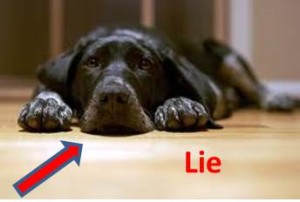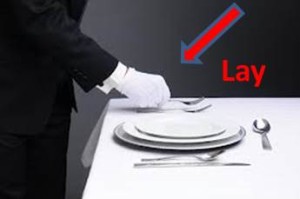I’d like to lay down a few simple rules so that you none of you lies under any doubt at all…about the difference between lay and lie.
These two little three-letter words seem to fox a number of people. Let’s see if we can clarify this just a tad.
see if we can clarify this just a tad.
Okay. We have two verbs here: to lay and to lie. To lay is followed by an object and is therefore a transitive verb and means to set or put something down carefully.To lie does not take an object and is therefore an intransitive verb. So, you cannot lie something. To lie means to be/assume in a  horizontal position, or rest or to be in a flat position. (For this post, we can ignore that to lie also means to tell an untruth).
horizontal position, or rest or to be in a flat position. (For this post, we can ignore that to lie also means to tell an untruth).
Here are some examples for ‘lay’:
I usually lay my Kindle on the bedside table after I’ve had a short read before going to sleep.
Elsie the chicken lays an egg every day.
I’m going to lay the table for lunch.
And some for ‘lie’:
I’m going to go and lie down and have a nap.
Sullington is a small village that lies in the heart of rural West Sussex.
The proof of the pudding lies in the eating.
What befuddles the brain is that the past tense of one is the same as the present tense of another. Let’s look at the conjugation of both these verbs:
Present tense Past tense Past participle
Lie (lying) Lay Lain
Today you lie down, yesterday you lay down and yesterday you had lain down.
Present tense Past tense Past participle
Lay (laying) Laid Laid
Today you lay the table, yesterday you laid the table and yesterday you had laid the table.
I wish I could come up with an easy and foolproof way to remember this, but the only way is to memorise the rule. However, once you have remembered which one takes an object and which doesn’t, it becomes second nature. Remember that you cannot lie something (down) and you cannot lay on the bed.
Let’s look at some more examples for ‘lie’:
I lay (past tense of lie) in bed for an extra hour on Sunday morning.
The path to success lay (past tense of lie) in good sales techniques.
The tree was lying across the road, causing traffic problems.
And a few more for ‘lay’:
Jessica laid (past tense of lay) the mat on the floor.
I remember laying my beach towel next to the blue sunshade, but it had disappeared when I came back from my swim.
Had I laid my bicycle down, it wouldn’t have toppled over.
And that’s all there is to it!


This is always a tough one. Even MS Word tells me I am wrong when I am not sometimes, particularly for “lay”. So “I lay down on the bed to take a nap” is correct – correct? Or am I still not getting it.
Actually, I see that that is an ambiguous one depending on what tense is implied. But if I say “She lay on the bed to take a nap” that makes makes it past tense so would be correct – right?
Correct!!!
I have wrangled and tangled with these words! Thank you for this! It will go a far way and be referred to often!
https://www.smashwords.com/books/view/339087
Thanks for laying all that on us 🙂
Bless you, Cathy. And a second blessing for not making “every day” one word in your example sentence. Maybe one of these days you could do a post on pairs like every day/everyday, some day/someday, a while/awhile, and…oh, heck, there’s another one Word continually tries to correct for me incorrectly, but I can’t think of what it is right now. I’ll be back…
Now, that’s a good topic for a post! I shall work on that!
Yay, thank you!
If I just write it without thinking about it I generally don’t have a problem; it’s one of those things you just know. If I question it I can sometimes confuse myself. Thanks for spelling it out, Cathy.
Indeed, I confused myself, while writing it!
for shame! “The proof lies in the pudding.” No, the proof of the pudding lies in the eating.
Quite so!
Hey, I’m a single guy. “Lie”: and “lay” generally go hand in hand.
You said it, Lin…..
Excellent explanation, Cathy! Remembering that Bob Dylan’s song, “Lay, Lady, Lay,” is grammatically incorrect tense-wise often helps, too.
Funnily enough, I nearly called this post just that! But then Lie, Lady, Lie just hasn’t got the same ‘ring’ to it!
But, ironically, it has the ring of truth. 🙂
I learned these two from context, but it’s great to know the actual rule behind them. Thank you.
Oh, I hate these words! And Word does not help out in most cases. If I really find myself in a pickle, I’ll just highlight the word to flag it for my editor. She’s a retired school teacher and usually sets me straight. But thanks for the simple breakdown of “lay:- that does help me- use when referring to an object, not a person. Yeah, I can get that one.
Great article!